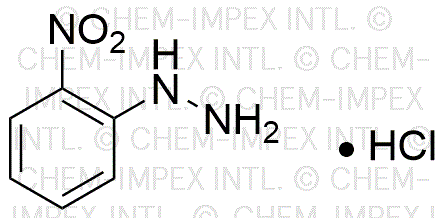2-Nitrophenylhydrazine hydrochloride is widely utilized in research focused on:
- Analytical Chemistry: This compound serves as a reagent for the detection and quantification of carbonyl compounds in various samples, enhancing the accuracy of analytical methods.
- Pharmaceutical Development: It plays a crucial role in the synthesis of pharmaceutical intermediates, particularly in the development of anti-cancer agents, providing a pathway for innovative drug formulations.
- Environmental Testing: The compound is used in environmental chemistry to analyze pollutants, especially in water samples, helping industries comply with environmental regulations.
- Biochemistry: It is utilized in the study of enzyme activity and protein interactions, offering insights into metabolic pathways and aiding in the development of biotechnological applications.
- Material Science: This chemical is involved in the synthesis of azo dyes and other organic compounds, contributing to advancements in textile and polymer industries.
General Information
Properties
Safety and Regulations
Applications
2-Nitrophenylhydrazine hydrochloride is widely utilized in research focused on:
- Analytical Chemistry: This compound serves as a reagent for the detection and quantification of carbonyl compounds in various samples, enhancing the accuracy of analytical methods.
- Pharmaceutical Development: It plays a crucial role in the synthesis of pharmaceutical intermediates, particularly in the development of anti-cancer agents, providing a pathway for innovative drug formulations.
- Environmental Testing: The compound is used in environmental chemistry to analyze pollutants, especially in water samples, helping industries comply with environmental regulations.
- Biochemistry: It is utilized in the study of enzyme activity and protein interactions, offering insights into metabolic pathways and aiding in the development of biotechnological applications.
- Material Science: This chemical is involved in the synthesis of azo dyes and other organic compounds, contributing to advancements in textile and polymer industries.
Documents
Safety Data Sheets (SDS)
The SDS provides comprehensive safety information on handling, storage, and disposal of the product.
Product Specification (PS)
The PS provides a comprehensive breakdown of the product’s properties, including chemical composition, physical state, purity, and storage requirements. It also details acceptable quality ranges and the product's intended applications.
Certificates of Analysis (COA)
Search for Certificates of Analysis (COA) by entering the products Lot Number. Lot and Batch Numbers can be found on a product’s label following the words ‘Lot’ or ‘Batch’.
*Catalog Number
*Lot Number
Certificates Of Origin (COO)
This COO confirms the country where the product was manufactured, and also details the materials and components used in it and whether it is derived from natural, synthetic, or other specific sources. This certificate may be required for customs, trade, and regulatory compliance.
*Catalog Number
*Lot Number
Safety Data Sheets (SDS)
The SDS provides comprehensive safety information on handling, storage, and disposal of the product.
DownloadProduct Specification (PS)
The PS provides a comprehensive breakdown of the product’s properties, including chemical composition, physical state, purity, and storage requirements. It also details acceptable quality ranges and the product's intended applications.
DownloadCertificates of Analysis (COA)
Search for Certificates of Analysis (COA) by entering the products Lot Number. Lot and Batch Numbers can be found on a product’s label following the words ‘Lot’ or ‘Batch’.
*Catalog Number
*Lot Number
Certificates Of Origin (COO)
This COO confirms the country where the product was manufactured, and also details the materials and components used in it and whether it is derived from natural, synthetic, or other specific sources. This certificate may be required for customs, trade, and regulatory compliance.


